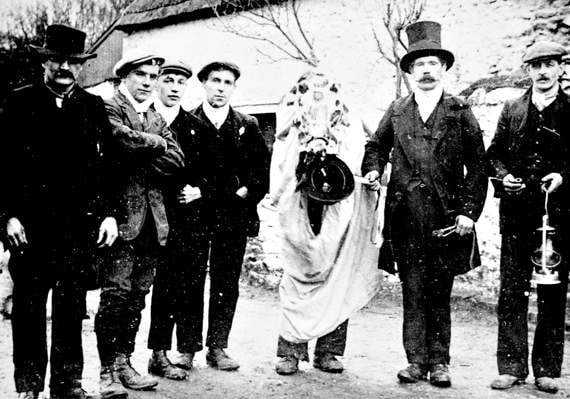From terrifying bauble-eyed eight-foot-tall horse skulls asking to be let into your house, to undead tail-less sows chasing your children home, Wales has a knack for spooky traditions.
With Halloween right around the corner, here are some of Cymru’s eeriest traditions that make the country the true home of the macabre.
Noson Galan Gaeaf
Before the globalised and commercialised day called ‘Halloween’, 13th Century Wales had Noson Galan Gaeaf.
Translated literally as ‘Winter’s Eve’, some argue Noson Galan Gaeaf originated from the ancient Celtic festival Samhain, commemorating the end of autumn harvest season and the beginning of winter.
Held on the last day of October, the eve of the Celtic New Year, the eve blurred the boundaries between life and death, when spirits roamed freely.
Noson Galan Gaeag was believed to be when the veil between this life and the afterlife was at its thinnest, and those celebrating took advantage by using it to say goodbye to those who had passed.

Hwch Ddu Gwta
Apparitions, ghosts and visions were common on this night, perhaps the most terrifying of which was the Hwch Ddu Gwta - the tailless black sow.
Spotted rising from the embers of a fire, he would chase the village children home.
In anticipation, the children would chant, ‘home, home, at once, the tailless black sow shall snatch the last one’.
Some say it was a real spirit, whilst others suspect it was a man draped in cloth or pig hide, teaching children the dangers of straying from the group and getting them home on time.
People would also watch out for ghosts seen at midnight on stiles, believed to be a liminal space where unbaptised children were often buried.
They would stay clear of graveyards, stiles and crossroads where the spirits were believed to gather.
Y Ladi Wen (the White Lady) was also known to appear on this night, haunting the sites of violent deaths and warning children against their bad behaviour.
Gwrachod
As with other Welsh traditions that vary across the country, so did the traditions of Noson Galan Gaeag.
In Glamorgan boys would dress in women’s clothing, whilst in South Wales groups of young people would go door to door much like modern-day trick-or-treaters.
But Powys had the gwrachod, meaning hags or witches.
Pairs of men would drink heavily whilst marauding around town dressed as old men or women.
Some moved in gangs whilst dressed in sheep skins, rags and masks, knocking on doors and demanding gifts.
The name harks back to the belief that witches or fiends would wreak destruction and havoc on that night.
In North Wales, gwrachod also described men and women who visited neighbours houses dressed in each other's clothes and masks, often combining forces with the winter tradition of the Mari Lwyd.

Mari Lwyd
In the depths of winter, Mari Lwyd appears.
She is an otherworldly vision - a horse's skull with bauble eyes and ribbons, draped in a sheet and carried above a person on a pole, animating the jaw.
The Mari Lwyd or Grey Mare is usually spotted around Christmas and New Year, dating back to 18th-century wassailing folk in south Wales.
But with her spectre-like looks and tradition of terrorizing neighbours with songs and antics in exchange for being let in, her scary likeness can often be spotted as early as Halloween.
Fortune telling
Along with the seemingly age-old tradition of using seasonal produce as games such as apple bobbing or turnip carving, fortune telling was also incredibly popular on Noson Galan Gaeaf.
People would want to know if an untimely death was expected or who was the next to marry.
Women would wander the boundaries of churches chanting ‘here is the sheath, where is the knife’ and wait eagerly to hear the name of the person they would marry.
If you ran around a church three times and peered into the keyhole at midnight, it was said you would see the faces of those who would die in the next year.
In some areas, stwmp naw rhyw was made - a mash of nine root vegetables plus milk, butter, salt and pepper, placing a wedding ring in the centre.
Whoever found the ring in their bowl would be the next to marry.
Women would throw apple peel over their shoulders, believing the shape of the peel would be the first initial of the name of their betrothed.
Coelcerth
Fires were also used to predict sudden death - in some parts of Wales, people would gather around a fire, each writing their names on stones.
The stones would be placed into the fire (coelcerth).
The next morning, the ashes would be searched for the stones - if the stone with your name on was missing, this would be seen as an omen of your coming untimely death.
Whilst 31 October looks very different now, there are commonalities seen with these ancient Welsh traditions from the use of seasonal produce and trick or treating.
However the overarching themes of fear of the dark and what lies therein, anticipation of the coming winter and reflecting on death and the afterlife are things that have endured through cultures, continents and centuries.

.png?width=209&height=140&crop=209:145,smart&quality=75)


